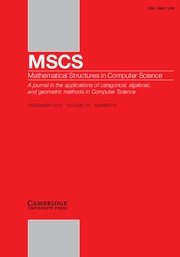This special issue contains extended versions of selected contributions presented at LSFA 2021 and LSFA 2022, the Sixteenth and Seventeenth editions of the Workshop on Logical and Semantic Frameworks with Applications. LSFA 2021 was held as a satellite event of the 6th Formal Structures for Computation and Deduction Conference (FSCD 2021). Although originally set to take place in Buenos Aires, Argentina, it was conducted entirely online due to the COVID pandemic. It was chaired by Mauricio Ayala Rincón and Eduardo Bonelli. LSFA 2022 took place in Belo Horizonte and was chaired by Pascal Fontaine and Daniele Nantes. It was also largely affected by the pandemic and took place in a hybrid modality.
Logical and Semantic Frameworks with Applications is a workshop series, which is dedicated to bring together theoreticians and practitioners in the field of computational logics and semantics to promote new techniques and results, from the theoretical side, and feedback on the implementation and the use of such techniques and results, from the practical side. In order to reach the quality standards of MSCS, all papers in this special issue have been carefully reviewed by specialists, including members of the LSFA 2021 and LSFA 2022 Program Committees as well as additional experts, for which the guest editors are grateful.
In the following, a short introduction is given to each of the five papers included in this volume.
The paper “Equational Theorem Proving for Clauses over Strings” by Dohan Kim introduces a new superposition calculus with strings and provides a saturation procedure for clauses over strings. The author proves that this calculus, when combined with the appropriate contraction rules, is refutationally complete. Notably, the paper also presents a new decision procedure for solving word problems over strings and a method for addressing unification problems modulo a set of conditional string equations R, provided that R admits finite saturation under the proposed inference system.
In “GADTs Are Not (Even Partial) Functors,” Pierre Cagne, Enrico Ghiorzi, and Patricia Johann investigate semantic approaches to generalized algebraic data types (GADTs) that extend the initial algebra semantics (IAS) of standard algebraic data types (ADTs). They show that functorial treatments in Set inevitably introduce “ghost elements” – values not representable in syntax – which break parametricity. Unlike ADTs, whose IAS matches their Church encodings in System F, GADTs resist such interpretations due to the inherent partiality of their map functions, a limitation that persists even in alternative categorical settings.
With an eye toward quantum programming languages, the paper “A Linear Lambda-Calculus” by Alejandro Díaz-Caro and Gilles Dowek extends intuitionistic multiplicative additive linear logic with addition and scalar multiplication and shows that the proof language of this logic expresses linear maps only: if f is a proof of an implication between two propositions, then f(u + v)= f(u)+ f(v)and f(a.u)=a.f(u).
In the paper “Adding an Implication to Logics of Perfect Paradefinite Algebras” by Vitor Greati, Sérgio Marcelino, João Marcos, and Umberto Rivieccio, the authors analyze expansions of the variety of algebras called perfect paradefinite algebras (PPAs) by means of a suitable implication connective. The latter concerns the (usual) single-conclusion and the multiple-conclusion consequence relations associated to PPAs, that the authors call, respectively, SET-SET and SET-FMLA logics. A brief algebraic study of some of the logics introduced in the paper is developed together with characterizations in terms of Hilbert-style analytic calculi.
The paper “Paraconsistent transition structures: compositional principles and a modal logic” by Ana Cruz, Alexandre Madeira, and Luís Soares Barbosa investigates paraconsistent transition systems. The latter are transition systems that incorporate the possibility of labeling the transitions with grades, indicating “how much” they are enabled and “how much” they are disabled. Furthermore, a category for this construction is presented, and the corresponding algebraic operators for this category are discussed. Also, a modal logic is presented for reasoning about such transition systems.
We wish to thank all the authors for contributing their papers and the referees for their time and thoughtful reviews.
Guest editors
Eduardo Bonelli
Daniele Nantes-Sobrinho


